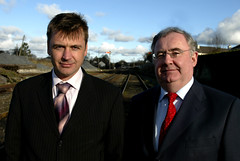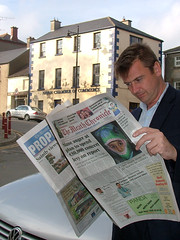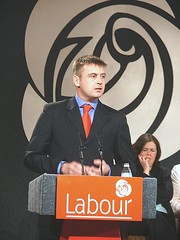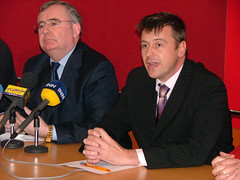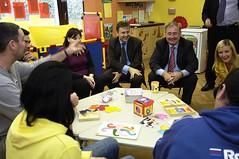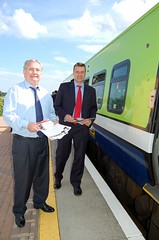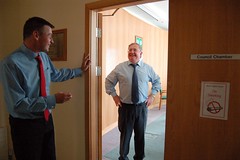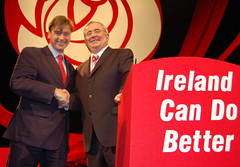Thursday, August 28, 2008
Last day in Chingeltei
Today was the last day of my placement in Chingeltei. I arrived in the office at 9am and met Uka and Namjilmaa for a last run through before our presentation started.
Uka had made some final changes to the presentation, including putting in pictures from my visit. The cover slide had me posing with an Eagle. It certainly livened up the presentation, which went quite well.
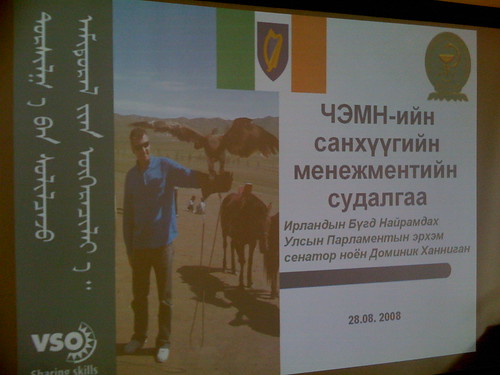
The first page of the presentation
I went through the key issues I had found, and suggested five recommendations. Basically the main problems are:
1. Equipment is outdated and needs replacing
2. The hospital buildings are in a very poor state of repair. There are also too many premises. We need a new building to replace these.
3. There is a lack of autonomy within the district. Too much of the control rests outside the district, with the Ministry.

Me in action
From the feedback I got I think it was generally well-received. Afterwards I got a presentation of a plaque, a cup with my picture on it and a cashmere sweater - the team were concerned that I hadn't brought winter clothing with me, so they thought I needed something warm!

Mugshot of me
We drove from the presentation to the National Television Centre (their equivalent of Montrose) where we met Alison, the VSO Country Director. We were ushered into the press conference room and kicked off with our press launch.
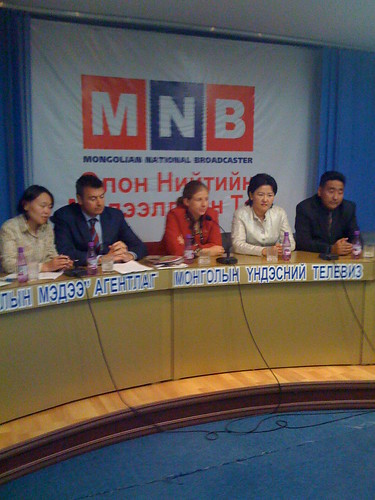
The team at the press launch
I outlined the nature and purpose of the visit and described the problems I had encountered and my recommendations for making things better. Afterwards I was approached by a number of the journalists for additional quotes (the national radio station was there as well).
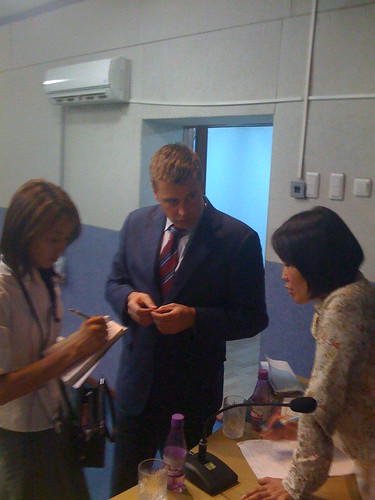
Discussing our recommendations with a radio journalist
I believe that we go out on the main news this evening, so I will be looking in!
By the time we got to the wedding the bride and groom had arrived. I had been working with the groom's mother over the last few weeks, so they had kindly invited me along. There were about 200 guests in the dining room, many of them in traditional Mongolian costumes.
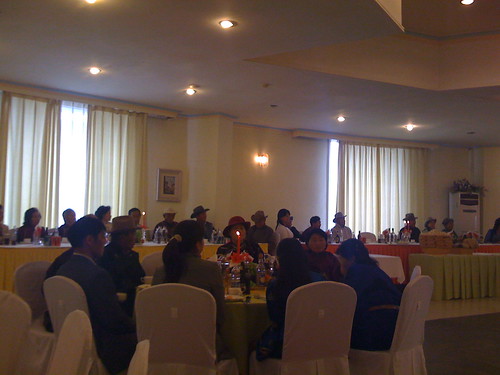
View of the top table
The set-up is similar to an Irish wedding, although one thing that they do which we don't is go round every table at the beginning of the meal and get one person at each table to introduce everyone. It breaks the ice and means that everyone had an idea of how others fit in to the event.
Just before we started the main course the compere called down to me and asked me to come up and say a few words. I had nothing prepared, so spoke briefly to the crowd, making sure to thank the wedding party for the invite and wishing them well for the future.
After the meal I gave my gift to the happy couple (some crystal) and went to the VSO for my exit interview. I think the interview went ok - at least they gave me my passport back, so I can now leave the country. I head back home early in the morning after what has been a very enjoyable and rewarding trip for me. I hope that I've managed to leave something positive behind!
Uka had made some final changes to the presentation, including putting in pictures from my visit. The cover slide had me posing with an Eagle. It certainly livened up the presentation, which went quite well.

The first page of the presentation
I went through the key issues I had found, and suggested five recommendations. Basically the main problems are:
1. Equipment is outdated and needs replacing
2. The hospital buildings are in a very poor state of repair. There are also too many premises. We need a new building to replace these.
3. There is a lack of autonomy within the district. Too much of the control rests outside the district, with the Ministry.

Me in action
From the feedback I got I think it was generally well-received. Afterwards I got a presentation of a plaque, a cup with my picture on it and a cashmere sweater - the team were concerned that I hadn't brought winter clothing with me, so they thought I needed something warm!

Mugshot of me
We drove from the presentation to the National Television Centre (their equivalent of Montrose) where we met Alison, the VSO Country Director. We were ushered into the press conference room and kicked off with our press launch.

The team at the press launch
I outlined the nature and purpose of the visit and described the problems I had encountered and my recommendations for making things better. Afterwards I was approached by a number of the journalists for additional quotes (the national radio station was there as well).

Discussing our recommendations with a radio journalist
I believe that we go out on the main news this evening, so I will be looking in!
By the time we got to the wedding the bride and groom had arrived. I had been working with the groom's mother over the last few weeks, so they had kindly invited me along. There were about 200 guests in the dining room, many of them in traditional Mongolian costumes.

View of the top table
The set-up is similar to an Irish wedding, although one thing that they do which we don't is go round every table at the beginning of the meal and get one person at each table to introduce everyone. It breaks the ice and means that everyone had an idea of how others fit in to the event.
Just before we started the main course the compere called down to me and asked me to come up and say a few words. I had nothing prepared, so spoke briefly to the crowd, making sure to thank the wedding party for the invite and wishing them well for the future.
After the meal I gave my gift to the happy couple (some crystal) and went to the VSO for my exit interview. I think the interview went ok - at least they gave me my passport back, so I can now leave the country. I head back home early in the morning after what has been a very enjoyable and rewarding trip for me. I hope that I've managed to leave something positive behind!
Wednesday, August 27, 2008
Putting the finishing touches to my final presentation
My flatmate Gecca moved out last night. She is off home to the Phillipeans. Already I am missing her - not just because she took the last of the chocolates and the tea with her, but also because she looked after me very well for the last few weeks.
Today being my penultimate day meant that I had to concentrate on pulling together my notes from the last two and a half weeks. I was surprised with just how much I had written down. I've gone through two copybooks in that period, speaking to many people along the way who were very generous with their time and advice.
I also spoke to a few patients to get some thoughts from them on how the system works. This morning parents came to the hospital to get their children inoculated. There were large queues forming when I arrived at 9am. I managed to speak to a few.
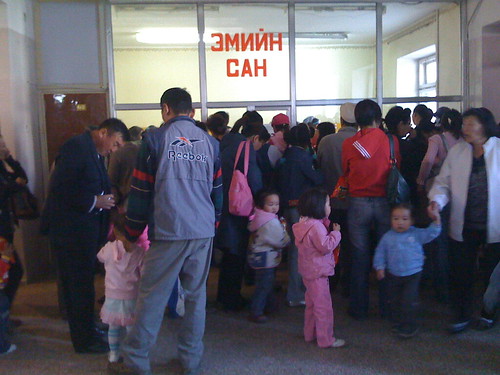
Children queue for their inoculations
My presentation is now largely complete. I ran it past the Director of the District and her assistant and they seemed happy enough.
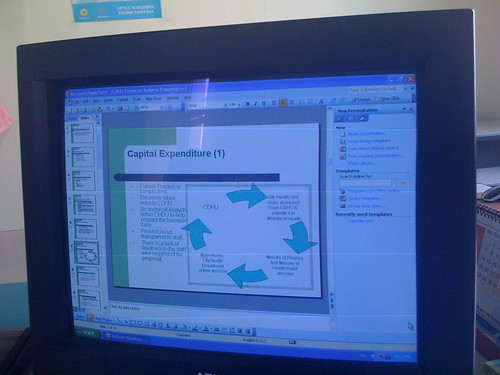
Slide from tomorrow's presentation
I am making five recommendations:
1. A review of the level of expenditure on health by central government
2. Implementation of the Asian Development Bank Project looking at structural reforms
3. More training in business planning for senior management staff
4. Better communication systems within the Health District
5. Work towards setting up the hospital as an autonomous unit
There are quite a few coming to the presentation and I'm hoping that the press conference afterwards will also be well attended. Then that's me done and I'm off to a Mongolian wedding before leaving for the airport!
Today being my penultimate day meant that I had to concentrate on pulling together my notes from the last two and a half weeks. I was surprised with just how much I had written down. I've gone through two copybooks in that period, speaking to many people along the way who were very generous with their time and advice.
I also spoke to a few patients to get some thoughts from them on how the system works. This morning parents came to the hospital to get their children inoculated. There were large queues forming when I arrived at 9am. I managed to speak to a few.

Children queue for their inoculations
My presentation is now largely complete. I ran it past the Director of the District and her assistant and they seemed happy enough.

Slide from tomorrow's presentation
I am making five recommendations:
1. A review of the level of expenditure on health by central government
2. Implementation of the Asian Development Bank Project looking at structural reforms
3. More training in business planning for senior management staff
4. Better communication systems within the Health District
5. Work towards setting up the hospital as an autonomous unit
There are quite a few coming to the presentation and I'm hoping that the press conference afterwards will also be well attended. Then that's me done and I'm off to a Mongolian wedding before leaving for the airport!
Tuesday, August 26, 2008
Visit to Darhan City Health Unit in Northern Mongolia
I travelled up to the northern city of Darhan this morning. We left UB at about 8am for the 250km journey. Once we left UB the road was surprisingly quiet and the driver was able to do about 80kph.
It was only on the journey that I noticed for the first time that although all vehicles drive on the right-hand side of the road, almost half of the cars have their steering wheel on the right-hand side of the car. I would love to see some research done as to whether the high road traffic accident rate is linked to right-hand drive vehicles here. I’d be surprised if there isn't any correlation.
At Darhan we met the Director of the City Health Department. He gave us an overview of the city and also of the problems facing the area. Darhan is the third largest city in Mongolia, with a population of about 100,000 people and like elsewhere in the country the health sector is in need of more funds for equipment and buildings.
The Norwegian aid program has been very active here. They have worked with the Health department for the last ten years to train local health staff and build capacity. We visited one of their training rooms to have a look.
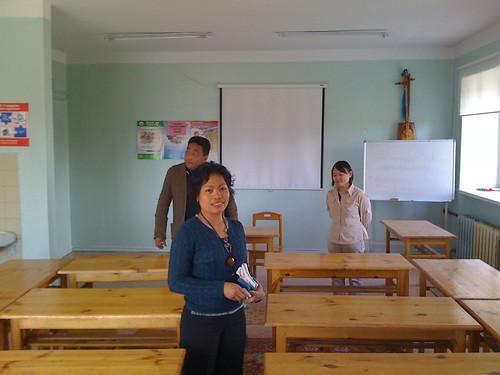
In a local training room
After our briefing the Director took us on a quick tour of Darsan, including a visit to the new suspension bridge outside the city(the first suspension bridge in Mongolia!).

View over Darhan
Although the sky was relatively clear the temperature was only about 15 degrees, well down on the temperatures of just a week ago.

View over the New Darhan suburb
It is quite shocking how quickly the temperature has dropped during my visit. When I first arrived a forthnight ago the days were very hot. Just two weeks later and although the sky is sunny the temperature is in the low teens, almost like a fresh November day in Ireland.
The Director was kind enough to invite us to lunch in his home, where we shared in a large feed of mutton, potatoes and carrots with his wife and daughters. I presented him with a small box of chocolates (which had unfortunately started to melt in the sunshine) after which we made or way back to UB. On the way back I did some preparatory work for my final presentation, which I need to finalise tomorrow.
It was only on the journey that I noticed for the first time that although all vehicles drive on the right-hand side of the road, almost half of the cars have their steering wheel on the right-hand side of the car. I would love to see some research done as to whether the high road traffic accident rate is linked to right-hand drive vehicles here. I’d be surprised if there isn't any correlation.
At Darhan we met the Director of the City Health Department. He gave us an overview of the city and also of the problems facing the area. Darhan is the third largest city in Mongolia, with a population of about 100,000 people and like elsewhere in the country the health sector is in need of more funds for equipment and buildings.
The Norwegian aid program has been very active here. They have worked with the Health department for the last ten years to train local health staff and build capacity. We visited one of their training rooms to have a look.

In a local training room
After our briefing the Director took us on a quick tour of Darsan, including a visit to the new suspension bridge outside the city(the first suspension bridge in Mongolia!).

View over Darhan
Although the sky was relatively clear the temperature was only about 15 degrees, well down on the temperatures of just a week ago.

View over the New Darhan suburb
It is quite shocking how quickly the temperature has dropped during my visit. When I first arrived a forthnight ago the days were very hot. Just two weeks later and although the sky is sunny the temperature is in the low teens, almost like a fresh November day in Ireland.
The Director was kind enough to invite us to lunch in his home, where we shared in a large feed of mutton, potatoes and carrots with his wife and daughters. I presented him with a small box of chocolates (which had unfortunately started to melt in the sunshine) after which we made or way back to UB. On the way back I did some preparatory work for my final presentation, which I need to finalise tomorrow.
Monday, August 25, 2008
I experience Mongolian Health Service as a Patient
I suppose that there's no better way of seeing the health service in operation than to experience what it is like for the end user. That’s what happened to me on Sunday night, when I had to take a detour to the chest X-Ray department.
My problem had begun on the first night I reached here. Someone texted me in the middle of the night and I got out of bed to get the phone. Unfortunately I stumbled and fell heavily on my left ribcage.
I was in a bit of pain for the following 10 days, and there was quite an amount of bruising, but I thought that I was probably just bruised and didn't bother to see anyone. The pain subsided to a large extend until this weekend, when my activities aggravated the condition.
After work on Friday myself and Leo had headed out to the Terelj district east of the capital. It's about a two hour drive, and with the flooded rivers it took a little bit longer. We arrived at our Ger and after went out for a cycle on our mountain bikes across the plains.
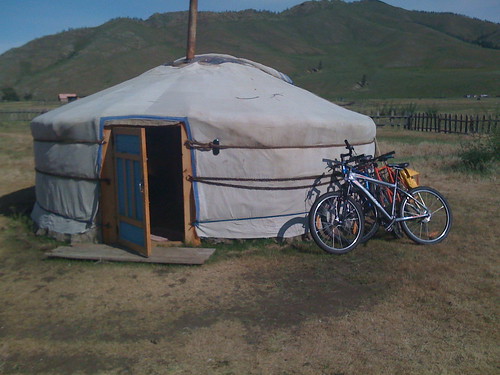
Our Ger in Terelj
That night we built a fire and whilst the cold wind was biting, we stayed out to watch the sky. Because of the lack of air pollution in Mongolia you have a marvelous view of the stars. We saw a very clear Milky Way, several constellations, a few satellites and a couple of shooting stars.
We also had a fire within the Ger, so although the temperature dropped during the night I managed to have a sound sleep. In the morning we went out for a ride on some Mongolian Horses.

Our horses
I've been on horse a few times before but would not consider myself an expert by any means. The trotting managed to give me a bit of pain and my ribcage was aching a little.
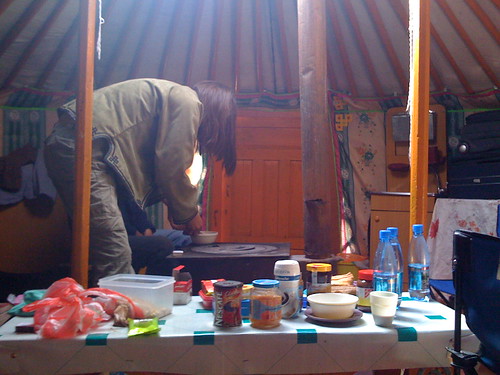
Lunch in our Ger
After lunch in our Ger we went canoeing for about 20km down the river. The temperature had picked up and it was quite a pleasant trip. However, I did notice an increasing level of pain in my ribs.
We got back to UB late and went out for a bite to eat. I got to bed by midnight since next morning I was accompanying the Senior Management Team to the countryside for an away-day.
We started off at the new monument to Chinggis Khan, about 40km outside the capital. It’s due to open officially in early September, but we were lucky enough to get an advance showing. Once again, I noticed the lack of quality on the construction techniques at the monument.

The new monument to Chinggis Khan
I also got my chance to hold an eagle. Not the most thrilling experience of my life, but it did seem to be the thing to do.

One very non-plussed eagle on my arm
We spent the day eating and talking about things in general, and specifically in relation to training needs within the health district.

With the Senior Management Team
We took a break to watch the two Mongolian Gold medal boxing fights and also to see Kenny Egan’s fight.
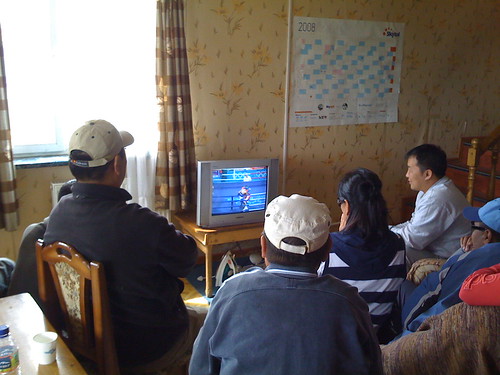
The Mongols go for gold in the boxing finals
The Mongols won one and lost one of their finals, but they were delighted with the result, and tears were evident. They were right behind Egan (A bit of the “Anyone but the Chinese” syndrome), but it was not to be.
On the way back to UB my pain started to get a bit worse, and when I mentioned it to one of the doctors he did a quick examination and announced that I had a fractured rib!
So, the minibus headed straight to the hospital, where we were brought to the X-Ray room.
After a bit of effort we finally managed to get an X-Ray taken. The result? I’ve been walking around for the last two weeks with a fractured rib.

With Director Tungelag and Namjillmaa, awaiting my X-Ray result
They bandaged me up and gave me painkillers, and told me that I’ll be right as rain in about a month. I suppose the lesson is not to answer text messages in the middle of the night!
It didn't stop me travelling down to Nailakh district on Monday morning. Nailakh has a population of about 30,000 and is about an hour's drive outside UB. We met with the Governor of the Region, who told us about the problems facing the area.
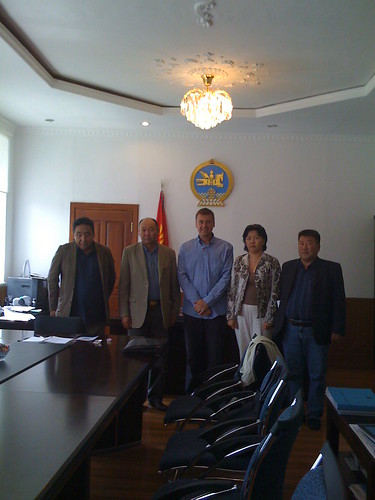
Myself and Chingeltei Senior Management Team with Nailakh's Governor
A key issue for them is the level of unemployment. When the Soviet Union collapsed many local factories closed - you can still see these derelict factories today.
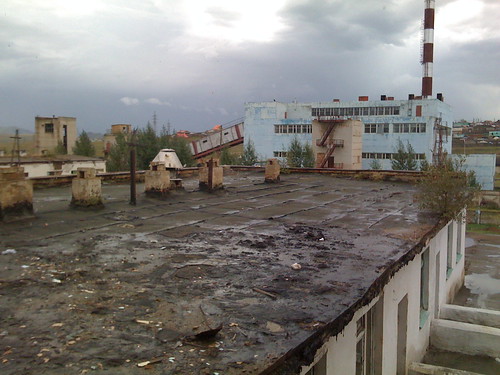
View of one of the derelict factories
One of the main sources of employment in the area is in mining for coal. As a result there are a lot of respiratory illnesses in the district. The aim of the Governor is to increase the number of jobs from tourism over the next decade.
My problem had begun on the first night I reached here. Someone texted me in the middle of the night and I got out of bed to get the phone. Unfortunately I stumbled and fell heavily on my left ribcage.
I was in a bit of pain for the following 10 days, and there was quite an amount of bruising, but I thought that I was probably just bruised and didn't bother to see anyone. The pain subsided to a large extend until this weekend, when my activities aggravated the condition.
After work on Friday myself and Leo had headed out to the Terelj district east of the capital. It's about a two hour drive, and with the flooded rivers it took a little bit longer. We arrived at our Ger and after went out for a cycle on our mountain bikes across the plains.

Our Ger in Terelj
That night we built a fire and whilst the cold wind was biting, we stayed out to watch the sky. Because of the lack of air pollution in Mongolia you have a marvelous view of the stars. We saw a very clear Milky Way, several constellations, a few satellites and a couple of shooting stars.
We also had a fire within the Ger, so although the temperature dropped during the night I managed to have a sound sleep. In the morning we went out for a ride on some Mongolian Horses.

Our horses
I've been on horse a few times before but would not consider myself an expert by any means. The trotting managed to give me a bit of pain and my ribcage was aching a little.

Lunch in our Ger
After lunch in our Ger we went canoeing for about 20km down the river. The temperature had picked up and it was quite a pleasant trip. However, I did notice an increasing level of pain in my ribs.
We got back to UB late and went out for a bite to eat. I got to bed by midnight since next morning I was accompanying the Senior Management Team to the countryside for an away-day.
We started off at the new monument to Chinggis Khan, about 40km outside the capital. It’s due to open officially in early September, but we were lucky enough to get an advance showing. Once again, I noticed the lack of quality on the construction techniques at the monument.

The new monument to Chinggis Khan
I also got my chance to hold an eagle. Not the most thrilling experience of my life, but it did seem to be the thing to do.

One very non-plussed eagle on my arm
We spent the day eating and talking about things in general, and specifically in relation to training needs within the health district.

With the Senior Management Team
We took a break to watch the two Mongolian Gold medal boxing fights and also to see Kenny Egan’s fight.

The Mongols go for gold in the boxing finals
The Mongols won one and lost one of their finals, but they were delighted with the result, and tears were evident. They were right behind Egan (A bit of the “Anyone but the Chinese” syndrome), but it was not to be.
On the way back to UB my pain started to get a bit worse, and when I mentioned it to one of the doctors he did a quick examination and announced that I had a fractured rib!
So, the minibus headed straight to the hospital, where we were brought to the X-Ray room.
After a bit of effort we finally managed to get an X-Ray taken. The result? I’ve been walking around for the last two weeks with a fractured rib.

With Director Tungelag and Namjillmaa, awaiting my X-Ray result
They bandaged me up and gave me painkillers, and told me that I’ll be right as rain in about a month. I suppose the lesson is not to answer text messages in the middle of the night!
It didn't stop me travelling down to Nailakh district on Monday morning. Nailakh has a population of about 30,000 and is about an hour's drive outside UB. We met with the Governor of the Region, who told us about the problems facing the area.

Myself and Chingeltei Senior Management Team with Nailakh's Governor
A key issue for them is the level of unemployment. When the Soviet Union collapsed many local factories closed - you can still see these derelict factories today.

View of one of the derelict factories
One of the main sources of employment in the area is in mining for coal. As a result there are a lot of respiratory illnesses in the district. The aim of the Governor is to increase the number of jobs from tourism over the next decade.
Friday, August 22, 2008
We meet some Irish Mongol Rally Teams
Last night we went out to a local pub quiz in Sukhbaatar Square. It was a pleasant experience, and we managed to come in 2nd out of ten teams. When I heard that one of the other teams was called "The Langers" I guessed that they were from Cork.
I approached them and sure enough they were from the real capital. They had just arrived by Lada car from London, via a whole lot of countries, as part of the yearly Mongol Rally. We joined them for a drink and also met another Irish Team who had just arrived. After hearing some of the horror stories about car breakdowns I think that it's one adventure I'd prefer to read about rather than experience at first hand.
My first meeting of the morning was with the Ministry of Health. They outlined the procedure for how expenditure plans are prepared and agreed.
When I got back to the office I was handed a small scroll, which when unfolded turned out to be a wedding invitation for next Thursday, which will be my last day of work here.
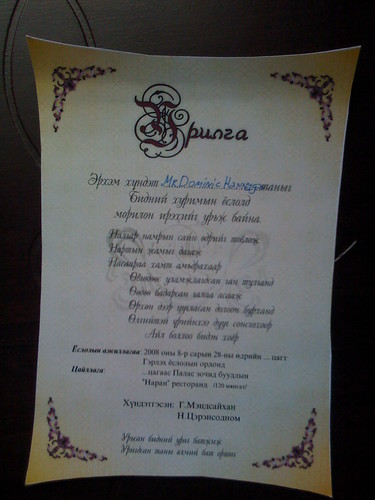
My Mongolian Wedding Invite
I'll certainly be attending. It will be my first time at a Mongolian Wedding and it should be fun.
I also had another meeting with some staff at the District. An emerging issue is the lack of communication and feedback within the organisation. I think I will address this in my list of recommendations next week.
I approached them and sure enough they were from the real capital. They had just arrived by Lada car from London, via a whole lot of countries, as part of the yearly Mongol Rally. We joined them for a drink and also met another Irish Team who had just arrived. After hearing some of the horror stories about car breakdowns I think that it's one adventure I'd prefer to read about rather than experience at first hand.
My first meeting of the morning was with the Ministry of Health. They outlined the procedure for how expenditure plans are prepared and agreed.
When I got back to the office I was handed a small scroll, which when unfolded turned out to be a wedding invitation for next Thursday, which will be my last day of work here.

My Mongolian Wedding Invite
I'll certainly be attending. It will be my first time at a Mongolian Wedding and it should be fun.
I also had another meeting with some staff at the District. An emerging issue is the lack of communication and feedback within the organisation. I think I will address this in my list of recommendations next week.
Thursday, August 21, 2008
Presentation on Effective Financial Management
During my three weeks in Mongolia I will be giving two presentations. The first one took place today and was entitled "Effective Financial Management". I widened the presentation to include some information about the health system in Ireland and also to talk about what I have learned in my time here so far.
The talk was attended by the director of the CHDU and the senior team, including the Head of Finance. I discussed issues such as budget planning, predicting the growth of current expenditure, how to justify new investment, Whole-life Costing, Budget monitoring and Auditing of Expenditure.
I also pointed out some issues with the current set-up, including:
The way that the health district gets funded is too complex
There is little autonomy for making financial decisions internally
There is little transparency as to how new investment is approved
The share of government spending on health, at 4.5% of GDP, is very low by international standards.

My presentation on Effective Financial Management
The presentation went on for about an hour and a half, and the conversation and questions continued over lunch afterwards.
I think the presentation was generally well-received. I meet with the Head of Finance in the morning to clarify some issues. The main thing is that we have identified the main issues facing the health unit, so now it should be possible to suggest some potential improvements.
The talk was attended by the director of the CHDU and the senior team, including the Head of Finance. I discussed issues such as budget planning, predicting the growth of current expenditure, how to justify new investment, Whole-life Costing, Budget monitoring and Auditing of Expenditure.
I also pointed out some issues with the current set-up, including:
The way that the health district gets funded is too complex
There is little autonomy for making financial decisions internally
There is little transparency as to how new investment is approved
The share of government spending on health, at 4.5% of GDP, is very low by international standards.

My presentation on Effective Financial Management
The presentation went on for about an hour and a half, and the conversation and questions continued over lunch afterwards.
I think the presentation was generally well-received. I meet with the Head of Finance in the morning to clarify some issues. The main thing is that we have identified the main issues facing the health unit, so now it should be possible to suggest some potential improvements.
Wednesday, August 20, 2008
Visit to the Christina Noble Children's Foundation
I spent the first part of the morning preparing for tomorrow's presentation. When I was happy with it we travelled out to Ambulatory 2 in the Ger district. The facility provides a medical service to over 70,000 people.
The building is quite dilapidated and really needs to be replaced, rather than refurbished. I made this point later to the Ministry of Finance, when I met them for a briefing on how the government allocates expenditure across departments.
After lunch myself and Leo met up with Eamon Thornton from the Christina Noble Children's Foundation. Eamon is the programme head in Mongolia. After volunteering with the CNCF for a year in 2002 he returned as a full-time staff officer 3 years ago.
Originally set up by Irishwoman Christina Noble in Vietnam, the Foundation is now active in many different ways in Mongolia. It helps with streetchildren living on the streets an in the sewers, it provides a drop-in medical clinic for kids. It also undertakes schooling in the boys and girls prisons.
It also provides direct financial assistance to 1,500 children and their families. For just $24 a month anyone can sponsor a child and their family, helping them eat, keeping them at school, basically improving their prospects in life.
Eamon briefed us on the operation on the way to the Ger children camp. The camp is home to 60 children. They have come to the camp in various ways.

The Ger village provides a home to 60 streetchildren
One boy was simply left at the front door by his parents. Another boy was brought to a local market and told to "Wait here" by his father, who promptly disappearded. Hours later, when the boy was still standing there crying the Foundation was called and they took him in.

Onsite playground
Another two little girls were found living in a cardboard box in a municipal dump - it is believed that their parents had both died.

Entertainment put on by the Sunshine Village children
The kids appeared to be very happy. We were given a tour of the kitchens, where dinner was being prepared. They also put on a mini-show for us. It was great to see how the contributions and efforts of our countrymen and countrywomen are making a huge difference to these childrens' lives.
The building is quite dilapidated and really needs to be replaced, rather than refurbished. I made this point later to the Ministry of Finance, when I met them for a briefing on how the government allocates expenditure across departments.
After lunch myself and Leo met up with Eamon Thornton from the Christina Noble Children's Foundation. Eamon is the programme head in Mongolia. After volunteering with the CNCF for a year in 2002 he returned as a full-time staff officer 3 years ago.
Originally set up by Irishwoman Christina Noble in Vietnam, the Foundation is now active in many different ways in Mongolia. It helps with streetchildren living on the streets an in the sewers, it provides a drop-in medical clinic for kids. It also undertakes schooling in the boys and girls prisons.
It also provides direct financial assistance to 1,500 children and their families. For just $24 a month anyone can sponsor a child and their family, helping them eat, keeping them at school, basically improving their prospects in life.
Eamon briefed us on the operation on the way to the Ger children camp. The camp is home to 60 children. They have come to the camp in various ways.

The Ger village provides a home to 60 streetchildren
One boy was simply left at the front door by his parents. Another boy was brought to a local market and told to "Wait here" by his father, who promptly disappearded. Hours later, when the boy was still standing there crying the Foundation was called and they took him in.

Onsite playground
Another two little girls were found living in a cardboard box in a municipal dump - it is believed that their parents had both died.

Entertainment put on by the Sunshine Village children
The kids appeared to be very happy. We were given a tour of the kitchens, where dinner was being prepared. They also put on a mini-show for us. It was great to see how the contributions and efforts of our countrymen and countrywomen are making a huge difference to these childrens' lives.
Tuesday, August 19, 2008
On LMFM from Mongolia
Before I left Ireland I did a radio interview with LMFM's "Loose Talk" show about my forthcoming visit to Mongolia. After the show we agreed that I would do an interview from Ulanbataar, to give an update on how I was getting on.
We arranged a time for the interview and I found a quiet room in the VSO building. Although I could hear Gerry fine I think that he had some problems hearing me, so I'm not sure how good the quality of the sound was when the broadcast went out.
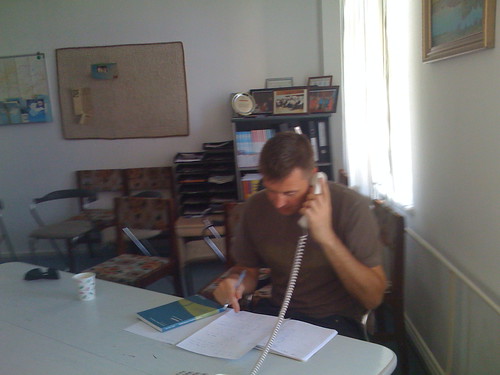
On the phone to LMFM
I got to visit Chingeltei's two "Polyclinics" today. They are located in separate buildings next to each other and house various clinics, including the Sexually Transmitted Disease centre, Ear Nose and Throat centre, the Tuberculosis centre, Cancer centre, Cardiology, Gynaecology, trauma, infectious diseases and eye surgery.
The Sexually Transmitted Disease and TB centres had recently been done up, thanks to funding from international donors. The incidence of TB is quite high here. There were 370 new cases diagnosed in the district last year, roughly about 1 per day. I asked whether any research had been carried out as to where cases were coming from. Seemingly there is a higher probability of the disease being found in residents from Ger district 7 and Ger district 12. When I asked whether these districts shared a commonality I was told that they were both close to the cemetery (the cemetery is huge and stretches for kilometers!). The doctors suggested that some people may have built their Gers over old graves and that this might have had an effect. I have no idea whether there is any medical link between TB and graves, but it was an interesting observation.
I was shown the Chest X-ray machine, which is specifically used for TB cases. the machine is quite dated and seemingly breaks down a lot.
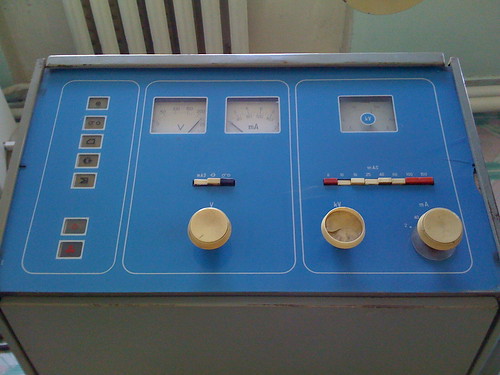
Chest X-ray machine from the '70s
I also got the chance to avail of some treatment myself, although I politely refused. I have had a sty in my eye for a few days now, brought on by a sand storm last week, I think. Anyway, it's nearly gone now but during my interview with the eye specialist she noticed my eye and suggested that she examine it. I agreed and before I knew it she was shipping me down to the treatment centre to get radiography heat treatment on it for a short burst of 8 minutes. Once again, I have no medical expertise to say whether this is the usual way to treat eye stys, but by the time I reached the centre I told my translator that I was happy to go without it.
The Surgery department deals with minor procedures, such as abscess removal and ingrown and infected toe-nails. When I arrived a young lady was having a toe-nail treated, so I didn't stay long. After each procedure the scalpels are sent for sterilisation, but don't return until the next day. Because there are so few they often run out of sterilised scalpels around lunchtime. When they do, any patients who are waiting are sent home and told to come back the next day.
After lunch I visited the Asian Development Bank and had a discussion with the Country Officer. He explained that Ireland was now a shareholder of the bank (we have 12,000 shares, or about 0.3% of the share capital). He's very optimistic for the country, pointing out that there are vast reserves of minerals such as coal and uranium. He thinks the country will grow and prosper in the not too distant future.
We arranged a time for the interview and I found a quiet room in the VSO building. Although I could hear Gerry fine I think that he had some problems hearing me, so I'm not sure how good the quality of the sound was when the broadcast went out.

On the phone to LMFM
I got to visit Chingeltei's two "Polyclinics" today. They are located in separate buildings next to each other and house various clinics, including the Sexually Transmitted Disease centre, Ear Nose and Throat centre, the Tuberculosis centre, Cancer centre, Cardiology, Gynaecology, trauma, infectious diseases and eye surgery.
The Sexually Transmitted Disease and TB centres had recently been done up, thanks to funding from international donors. The incidence of TB is quite high here. There were 370 new cases diagnosed in the district last year, roughly about 1 per day. I asked whether any research had been carried out as to where cases were coming from. Seemingly there is a higher probability of the disease being found in residents from Ger district 7 and Ger district 12. When I asked whether these districts shared a commonality I was told that they were both close to the cemetery (the cemetery is huge and stretches for kilometers!). The doctors suggested that some people may have built their Gers over old graves and that this might have had an effect. I have no idea whether there is any medical link between TB and graves, but it was an interesting observation.
I was shown the Chest X-ray machine, which is specifically used for TB cases. the machine is quite dated and seemingly breaks down a lot.

Chest X-ray machine from the '70s
I also got the chance to avail of some treatment myself, although I politely refused. I have had a sty in my eye for a few days now, brought on by a sand storm last week, I think. Anyway, it's nearly gone now but during my interview with the eye specialist she noticed my eye and suggested that she examine it. I agreed and before I knew it she was shipping me down to the treatment centre to get radiography heat treatment on it for a short burst of 8 minutes. Once again, I have no medical expertise to say whether this is the usual way to treat eye stys, but by the time I reached the centre I told my translator that I was happy to go without it.
The Surgery department deals with minor procedures, such as abscess removal and ingrown and infected toe-nails. When I arrived a young lady was having a toe-nail treated, so I didn't stay long. After each procedure the scalpels are sent for sterilisation, but don't return until the next day. Because there are so few they often run out of sterilised scalpels around lunchtime. When they do, any patients who are waiting are sent home and told to come back the next day.
After lunch I visited the Asian Development Bank and had a discussion with the Country Officer. He explained that Ireland was now a shareholder of the bank (we have 12,000 shares, or about 0.3% of the share capital). He's very optimistic for the country, pointing out that there are vast reserves of minerals such as coal and uranium. He thinks the country will grow and prosper in the not too distant future.
Monday, August 18, 2008
Visit to the Mongolian Women Farmers' Association
I spent the morning at home preparing a draft report for my seminar on Thursday on Effective Financial Management of Health Systems. I put it together based on the information I gathered last week coupled with my own knowledge of different systems. I was relatively happy with it by about 1:30pm and then headed into the office.
Namjillmaa met me and we spent the next couple of hours going through the presentation slide by slide. Namjillmaa must now translate each slide into Mongolian, so it's important that she knows and understands exactly what I am saying.
I left the office at 4:15pm and met Ruth from the VSO. We travelled on a Microbus to an outlying Ger district to see one of her projects. For the last year she has been working with the Mongolian Women Farmers Assoicaiton at their Ger farm.
The Ger farm is used to teach local Ger dwellers how to grow vegetables and keep some livestock. It's intention is to make Ger dwellers more self-sufficient in their food needs. Ruth showed me around the project. There are a range of vegetables growing, both indoors and outdoors. All are organic.
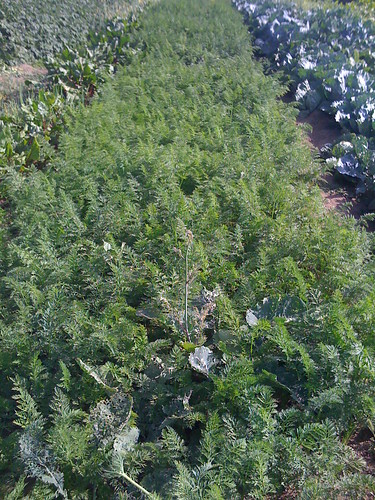
Carrots growing at the Ger farm
Apart from vegetables the farm also raises chickens and rabbits. They teach students about animal husbandry. Whilst chickens are becoming more popular as a food source in Mongolia, they are finding it difficult to encourage people to grow rabbits as a source of meat.
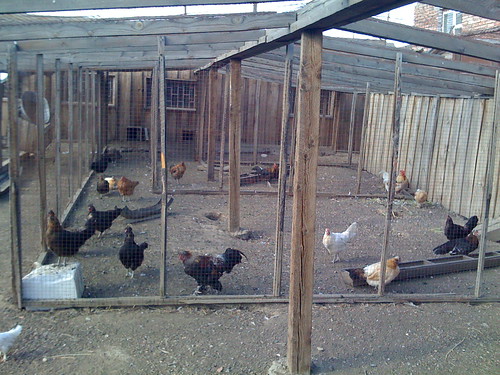
Organic Chickens in the pen
The size of the farm is roughly twice the size of the standard Ger enclosure, but there is still sufficient space available in a standard Ger enclosure to provide more than enough of a family's needs. Since the project has started in 1999 over 4,500 families have learned how to grow their own food.
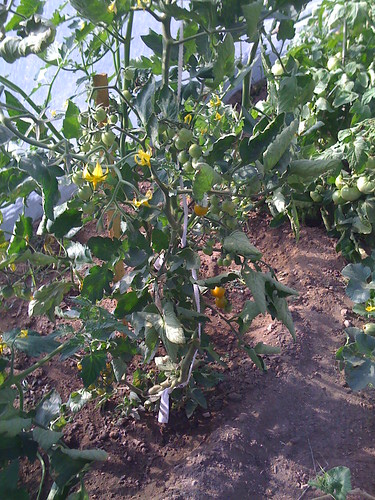
Tomatoes almost ready for picking
You can also stay at the farm for just $5 a night. In return, you get to experience life in a Ger district whilst contributing to an environmentally friendly organisation - you even get to help out with some farming if you want to. Ring them at 976 11 306 187 or on mobile at 99 177 666.
Namjillmaa met me and we spent the next couple of hours going through the presentation slide by slide. Namjillmaa must now translate each slide into Mongolian, so it's important that she knows and understands exactly what I am saying.
I left the office at 4:15pm and met Ruth from the VSO. We travelled on a Microbus to an outlying Ger district to see one of her projects. For the last year she has been working with the Mongolian Women Farmers Assoicaiton at their Ger farm.
The Ger farm is used to teach local Ger dwellers how to grow vegetables and keep some livestock. It's intention is to make Ger dwellers more self-sufficient in their food needs. Ruth showed me around the project. There are a range of vegetables growing, both indoors and outdoors. All are organic.

Carrots growing at the Ger farm
Apart from vegetables the farm also raises chickens and rabbits. They teach students about animal husbandry. Whilst chickens are becoming more popular as a food source in Mongolia, they are finding it difficult to encourage people to grow rabbits as a source of meat.

Organic Chickens in the pen
The size of the farm is roughly twice the size of the standard Ger enclosure, but there is still sufficient space available in a standard Ger enclosure to provide more than enough of a family's needs. Since the project has started in 1999 over 4,500 families have learned how to grow their own food.

Tomatoes almost ready for picking
You can also stay at the farm for just $5 a night. In return, you get to experience life in a Ger district whilst contributing to an environmentally friendly organisation - you even get to help out with some farming if you want to. Ring them at 976 11 306 187 or on mobile at 99 177 666.
Sunday, August 17, 2008
Countryside around Ulanbataar
I spent the weekend checking out some of the sights within UB and close by. Our first port of call was to the local Monastery, where we saw a fantastically tall Buddha and listened as scores of monks chanted in meditation.

Outside the main monastery, housing the statue of Buddha
We hopped in a taxi and travelled across the city to the Big Buddha statue on the banks of the river.
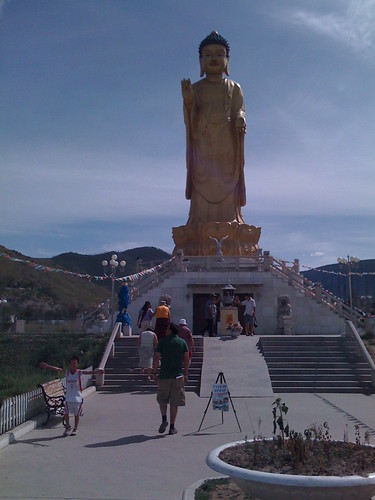
Big Buddha statue outside UB
From the Buddha statue we climbed the hill to the Russian / Mongolian friendship monument. It was only about 10 minutes to the top, but it was worthwhile. Apart from the fact that it's quite an impressive structure, the views over the city were magnificent.

The view from the Soviet / Mongolian Friendship monument in the hills over UB
That evening we attended a dinner in one of the volunteers houses. I got speaking to a local Catholic priest, who is involved in pastoral work with young people around the city. I took his number with the hope of meeting up with him later on in my placement to visit his mission.
On Sunday morning we set off to for a Ger tourist camp in the countryside with the new volunteers, who had just arrived yesterday. On the way we stopped at a few vantage points, including this prayer mound. I walked around the mound each time, each time placing a stone on the top of the mound.

Volunteers Gecca and Ruth attempting to throat sing
We eventually arrived at the tourist camp in the hills. It's like a mini-adventure centre and gives tourists the opportunity to stay overnight and get a bit of a feel for what life is like living in a Ger tent. I stayed in a few last time I was here and experienced them then.
Lunch was an hour away and after having been cooped up in the bus for so long I decided to go for a hike in the surrounding hills.
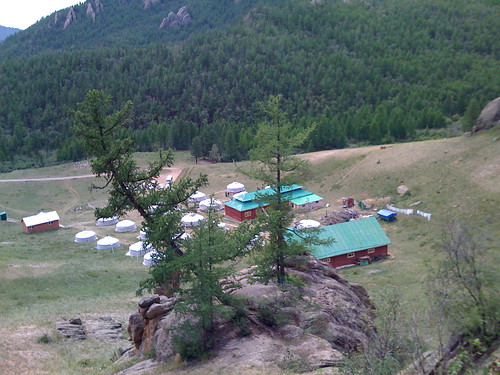
The GER camp for tourists
I got back after an hour or so, but there was still no sign of lunch. It eventually arrived at about 3 o' cock, two hours later than expected. We were all ravenous. It was a local Mutton BBQ. The sheep, freshly killed this morning, was hacked up into pieces and boiled in an urn with potatoes and hot stones. The end result can be seen below.
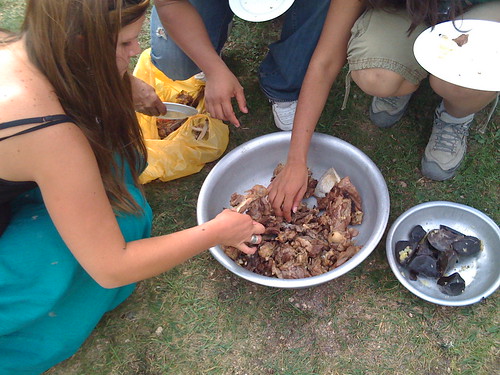
Choosing the mutton cuts from the BBQ
The meat was very tender, although there was quite a lot of fat on the bones. All in all, I'd have to say that I prefer my meat cuts in the more traditional manner.

Outside the main monastery, housing the statue of Buddha
We hopped in a taxi and travelled across the city to the Big Buddha statue on the banks of the river.

Big Buddha statue outside UB
From the Buddha statue we climbed the hill to the Russian / Mongolian friendship monument. It was only about 10 minutes to the top, but it was worthwhile. Apart from the fact that it's quite an impressive structure, the views over the city were magnificent.

The view from the Soviet / Mongolian Friendship monument in the hills over UB
That evening we attended a dinner in one of the volunteers houses. I got speaking to a local Catholic priest, who is involved in pastoral work with young people around the city. I took his number with the hope of meeting up with him later on in my placement to visit his mission.
On Sunday morning we set off to for a Ger tourist camp in the countryside with the new volunteers, who had just arrived yesterday. On the way we stopped at a few vantage points, including this prayer mound. I walked around the mound each time, each time placing a stone on the top of the mound.

Volunteers Gecca and Ruth attempting to throat sing
We eventually arrived at the tourist camp in the hills. It's like a mini-adventure centre and gives tourists the opportunity to stay overnight and get a bit of a feel for what life is like living in a Ger tent. I stayed in a few last time I was here and experienced them then.
Lunch was an hour away and after having been cooped up in the bus for so long I decided to go for a hike in the surrounding hills.

The GER camp for tourists
I got back after an hour or so, but there was still no sign of lunch. It eventually arrived at about 3 o' cock, two hours later than expected. We were all ravenous. It was a local Mutton BBQ. The sheep, freshly killed this morning, was hacked up into pieces and boiled in an urn with potatoes and hot stones. The end result can be seen below.

Choosing the mutton cuts from the BBQ
The meat was very tender, although there was quite a lot of fat on the bones. All in all, I'd have to say that I prefer my meat cuts in the more traditional manner.
Friday, August 15, 2008
Ulanbataar erupts in celebration of Judo gold
The town went totally mad last night when local Judo star Tuvshinbayar Naidan won Mongolia's first ever gold. I was having dinner at the time and the entire restaurant was cheering him on as he fought his way to victory. For the remainder of the night people moved out onto the streets, and all the traffic blasted their horns in celebration. It was akin to celebrations you see when a country wins the World Cup.
I visited one of the local bars with Leo and we got talking to a selection of various travellers, including a crowd from Spain, a crowd from America and some Swedes. The Europe to Mongolia rally is finishing up this weekend and many of the teams had just arrived.
I walked home through Sukhbataar Square just after midnight. The place was still very much alive with joyous Mongols.
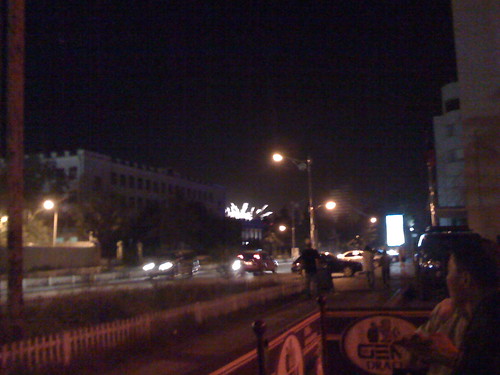
Fireworks go off on Sukhbataar Square as Mongolia win gold
I started the day with a visit to the main hospital in the Chingletei District. It's got 167 beds, but no operating theatre. Originally designed as an office, there are few facilities for patients. On one floor a total of 44 patients share a small 2 closet toilet.
I also visit the Intensive Care Unit. There are two heart monitoring machines to be shared amongst the 7 patients. The Doctor has to prioritise their allocation on the basis of need. The beds were very basic and only one bed had oxygen. The need for equipment was very obvious. Where there is equipment it is often very dated. The X-Ray machine, which is the only one in the entire district, was made in 1968, forty years ago.
I got back to the office for a meeting with the Chair Professor in the Institute of Health Care Administration at Asia university, Professor Chih-Liang Yaung. Professor Yaung is visiting Mongolia with some students and was interested in meeting me to discuss my thoughts to date. We discussed the situation in relation to health insurance payments and the finances of the hospital. From his experience he was firmly of the view that the hospital authority needs to be given more autonomy.
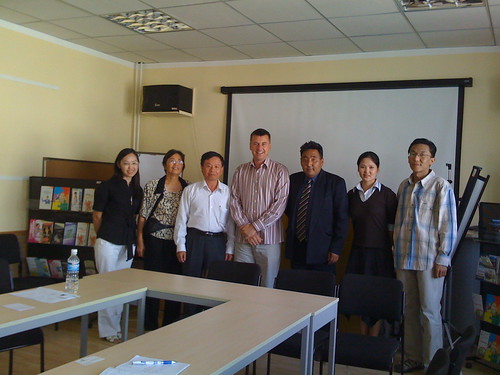
Professor Yaung, myself, CHDU staff and students from Asia University
Afterwards we went to the Family Group Practice in the 6th District, where we were met by the Practice Manager.

The exterior of the Group Practice, 6th District
The Manager gave us a tour of the practice. One of her main concerns is the structure of the building. It's quite dated, as can be seen from the picture above. The building is the primary point of medical attention for 8,000 people but yet there is no water supply coming into the building - it has to be carried in.
I finished the day with a two hour meeting discussing the cash planing and financial management processes for the Health Unit and for the Department of Health in general. It was very worthwhile, in that my overall knowledge of the system is a lot clearer than it was before the meeting.
I visited one of the local bars with Leo and we got talking to a selection of various travellers, including a crowd from Spain, a crowd from America and some Swedes. The Europe to Mongolia rally is finishing up this weekend and many of the teams had just arrived.
I walked home through Sukhbataar Square just after midnight. The place was still very much alive with joyous Mongols.

Fireworks go off on Sukhbataar Square as Mongolia win gold
I started the day with a visit to the main hospital in the Chingletei District. It's got 167 beds, but no operating theatre. Originally designed as an office, there are few facilities for patients. On one floor a total of 44 patients share a small 2 closet toilet.
I also visit the Intensive Care Unit. There are two heart monitoring machines to be shared amongst the 7 patients. The Doctor has to prioritise their allocation on the basis of need. The beds were very basic and only one bed had oxygen. The need for equipment was very obvious. Where there is equipment it is often very dated. The X-Ray machine, which is the only one in the entire district, was made in 1968, forty years ago.
I got back to the office for a meeting with the Chair Professor in the Institute of Health Care Administration at Asia university, Professor Chih-Liang Yaung. Professor Yaung is visiting Mongolia with some students and was interested in meeting me to discuss my thoughts to date. We discussed the situation in relation to health insurance payments and the finances of the hospital. From his experience he was firmly of the view that the hospital authority needs to be given more autonomy.

Professor Yaung, myself, CHDU staff and students from Asia University
Afterwards we went to the Family Group Practice in the 6th District, where we were met by the Practice Manager.

The exterior of the Group Practice, 6th District
The Manager gave us a tour of the practice. One of her main concerns is the structure of the building. It's quite dated, as can be seen from the picture above. The building is the primary point of medical attention for 8,000 people but yet there is no water supply coming into the building - it has to be carried in.
I finished the day with a two hour meeting discussing the cash planing and financial management processes for the Health Unit and for the Department of Health in general. It was very worthwhile, in that my overall knowledge of the system is a lot clearer than it was before the meeting.
Thursday, August 14, 2008
My first appearance on Mongolian TV
I found it hard to sleep much last night. A crowd of Mongolians decided to have a party in the area beneath my window, and they were quite loud. I was surprised that no police came along to move them on. They must have disturbed a few thousand sleepers in the buildings surrounding the square.
The day stated off with a meeting with the Primary Care Director of the Health District. He provided me with an overview of how the system operates. Each of the GP practices lacks equipment such as ECG, ultrasound and blood and urine testing devices.
The meeting was interrupted by a pre-scheduled interview with TV9, the Ulanbataar television station. I was asked the reason why I had come to the city and also questioned about the type of project I was doing. Of course, the interview was in Mongolian so Namjillma my translator will be speaking over my voice when it goes out on the air tonight.
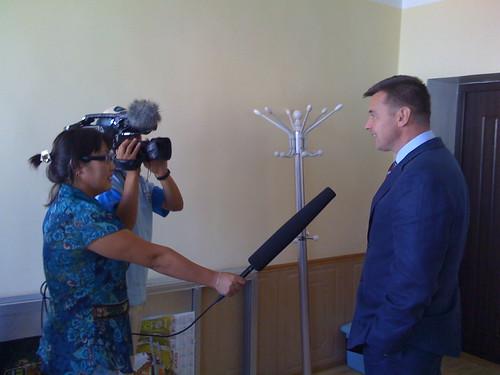
Getting Interviewed by TV9
We went for lunch around the corner from the HQ building. Some of the dish names seemed to have lost something in translation. You could have tried the "Ladies", or the "Horse Meat", or for the adventurous you could go for the "cowboy". There was also a dish called "Wind", which sounded very unappetising. I went for the horse meat, which turned out to be ok.
After lunch we went to visit a General Practice. The Practice covers 1,350 families in a city centre apartment district, which can be seen below.
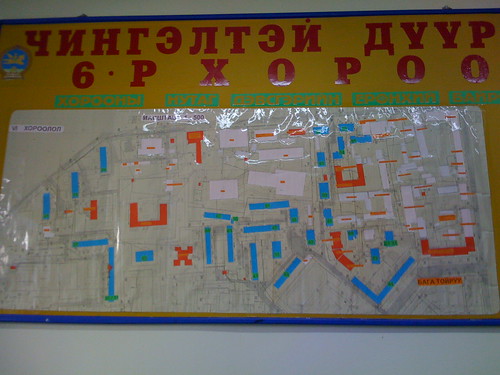
Map showing Chongeltei District
The head of the practice explained how the system operates. A major cause of annoyance for her is the amount of paperwork that has to be completed. Some of this could be removed by introducing a computer system across the health district. But it also requires the removal of some layers of bureaucracy. The Ministry of Health has introduced 17 new procedures or requirements over the last few years but has not increased resources at the same time. For instance, one of the 17 requirements is that the practice has to update the number of females between the ages of 16-49 (referred to as "females of child-bearing age") every year. In the absence of any computerised records this requires them to personally call to every house in the district every year.
The Head of Practice also referred to the lack of basic equipment, such as weighing scales and ink for her printer. I noticed for myself the quality of the workmanship of the builders. The practice building was only 3 yeas old but when they asked me, I guessed 40!
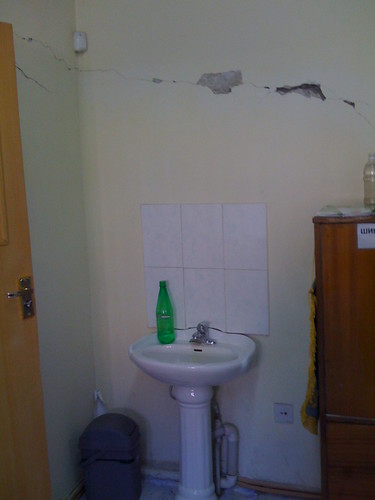
The inside of a GP practice. This building is just 3 years old!
The day stated off with a meeting with the Primary Care Director of the Health District. He provided me with an overview of how the system operates. Each of the GP practices lacks equipment such as ECG, ultrasound and blood and urine testing devices.
The meeting was interrupted by a pre-scheduled interview with TV9, the Ulanbataar television station. I was asked the reason why I had come to the city and also questioned about the type of project I was doing. Of course, the interview was in Mongolian so Namjillma my translator will be speaking over my voice when it goes out on the air tonight.

Getting Interviewed by TV9
We went for lunch around the corner from the HQ building. Some of the dish names seemed to have lost something in translation. You could have tried the "Ladies", or the "Horse Meat", or for the adventurous you could go for the "cowboy". There was also a dish called "Wind", which sounded very unappetising. I went for the horse meat, which turned out to be ok.
After lunch we went to visit a General Practice. The Practice covers 1,350 families in a city centre apartment district, which can be seen below.

Map showing Chongeltei District
The head of the practice explained how the system operates. A major cause of annoyance for her is the amount of paperwork that has to be completed. Some of this could be removed by introducing a computer system across the health district. But it also requires the removal of some layers of bureaucracy. The Ministry of Health has introduced 17 new procedures or requirements over the last few years but has not increased resources at the same time. For instance, one of the 17 requirements is that the practice has to update the number of females between the ages of 16-49 (referred to as "females of child-bearing age") every year. In the absence of any computerised records this requires them to personally call to every house in the district every year.
The Head of Practice also referred to the lack of basic equipment, such as weighing scales and ink for her printer. I noticed for myself the quality of the workmanship of the builders. The practice building was only 3 yeas old but when they asked me, I guessed 40!

The inside of a GP practice. This building is just 3 years old!
Wednesday, August 13, 2008
We make news in The Mongol Messenger
My day started with a three hour session with the Head of Finance and Chief Economist in the Chingeltei District Health Unit (CHDU). They spent the morning explaining the way in which money comes into the health budget. The health system is funded from a range of sources: central taxation, contributions from health insurance, ancilliary income (for example from renting out space to private pharmacies operating on the public hospitals grounds) and income from sources such as tourists requiring treatment.
It was a fairly intense meeting. Because of the need to translate I had to go back and forth with my questioning a few times just to make sure that I understood what I was being told (for instance, "Fixed Assets" was translated as "Non Moving Assets").We agreed at the end that I would go back to them to clarify any issues that I didn't fully understand.
At lunch we met with Mr Peter O'Brien, the Deputy Head of the UK Mission in Mongolia and the person who deals with any issues that arise in relation to Irish citizens here. Peter told us that there are only about 10 Irish people living in Mongolia on a full-time basis. That struck me as low, since I've already seen the outside of FOUR Irish pubs here, and I've only been here 4 four days. I stuck my head into one, there was little that was particularly Irish about it - they weren't even playing U2 - so I went to a Korean place instead. Peter asked us along for a visit to the Embassy on Friday evening, which with luck we may be able to accept.
Lunch was served very slowly and we ended up being ten minutes late for our meeting with the Minister of Health, Prof Byambaa Batsereedene. She was extremely welcoming and expressed the hope that our visit would lead to additional ties between our two countries.
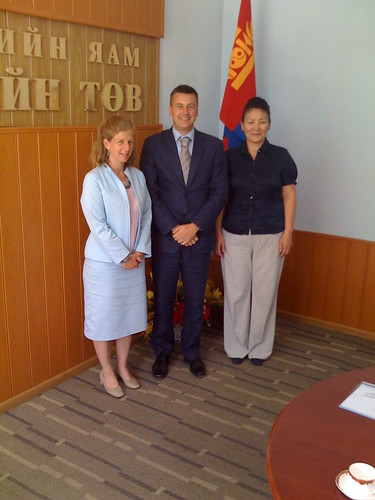
With the Minister of Health, Prof Byambaa Batsereedene and VSO Country Chief Alison Rusinow
We also visited the United Nations Population Fund Country Representative Ms Delia Barcelona where we had a chat about the country's demographics. One area of concern is the low level of educational attainment for boys. Many leave school early to work with their livestock, as a result there is a huge disparity between the educational achievements of girls and boys. This means that in middle-management and office jobs the majority of appointments are women. At the same time there does appear to be a glass ceiling in place, in that all the top jobs still go to men. Certainly some changes are needed to address both of these issues.
At a brief meeting with the World Health Organisation Country Chief he informed us that our visit had attracted the attention of the local English Language newspaper. Here's the article.

Reports of our placement in "The Mongol Messenger"
The other volunteers have made sure that we are welcome and part of the group. My flatmate Gemmamarie cooked us up a traditional Phillipino disk called Adobo chicken last night, which we washed down with some Mead, brought from Ireland by Leo.

Dinner with other VSO volunteers at Daniel's house
It was a fairly intense meeting. Because of the need to translate I had to go back and forth with my questioning a few times just to make sure that I understood what I was being told (for instance, "Fixed Assets" was translated as "Non Moving Assets").We agreed at the end that I would go back to them to clarify any issues that I didn't fully understand.
At lunch we met with Mr Peter O'Brien, the Deputy Head of the UK Mission in Mongolia and the person who deals with any issues that arise in relation to Irish citizens here. Peter told us that there are only about 10 Irish people living in Mongolia on a full-time basis. That struck me as low, since I've already seen the outside of FOUR Irish pubs here, and I've only been here 4 four days. I stuck my head into one, there was little that was particularly Irish about it - they weren't even playing U2 - so I went to a Korean place instead. Peter asked us along for a visit to the Embassy on Friday evening, which with luck we may be able to accept.
Lunch was served very slowly and we ended up being ten minutes late for our meeting with the Minister of Health, Prof Byambaa Batsereedene. She was extremely welcoming and expressed the hope that our visit would lead to additional ties between our two countries.

With the Minister of Health, Prof Byambaa Batsereedene and VSO Country Chief Alison Rusinow
We also visited the United Nations Population Fund Country Representative Ms Delia Barcelona where we had a chat about the country's demographics. One area of concern is the low level of educational attainment for boys. Many leave school early to work with their livestock, as a result there is a huge disparity between the educational achievements of girls and boys. This means that in middle-management and office jobs the majority of appointments are women. At the same time there does appear to be a glass ceiling in place, in that all the top jobs still go to men. Certainly some changes are needed to address both of these issues.
At a brief meeting with the World Health Organisation Country Chief he informed us that our visit had attracted the attention of the local English Language newspaper. Here's the article.

Reports of our placement in "The Mongol Messenger"
The other volunteers have made sure that we are welcome and part of the group. My flatmate Gemmamarie cooked us up a traditional Phillipino disk called Adobo chicken last night, which we washed down with some Mead, brought from Ireland by Leo.

Dinner with other VSO volunteers at Daniel's house
Tuesday, August 12, 2008
Chingeltei District Health Unit
I reported for duty at the HQ of Chingeltei District Health Unit (CDHU) this morning. The first person I was introduced to was Jill, my interpreter, who is going to translate for me for the next three weeks. Jill is a General Surgeon by training and spent a few years in Auckland, New Zealand, before returning to Ulanbataar (UB).
We met with the Director of the CHDU and her staff and had a one-hour question and answer session about the District and about what they hoped that I could help with over the coming few weeks. They also gave me an overview of the area they work in.
UB is split up into 9 Duuregs. Each has their own local government structure. I have been assigned to the Chingeltei district. It's population is about 160,000 (about the size of Meath) and it stretches from the city centre right out to the hills surrounding the capital. There are 18 sub-districts, or Khoroos, different in character and ranging from city businesses to Ger encampments.
CHDU has 18 family General Practices (like local GPS), one for each Khoroo. Each deals with between 3,000 and 10,000 people. Usually these have between 4-6 doctors and 4-6 nurses. There are NO administrative staff. All reception work and filing is done by the doctors and nurses themselves.
There are also two ambulatory buildings (assessment, consultation, dental services, outpatients) two polyclinics and one General hospital.
The Director then took me to meet some key people in other institutions. The first was the Chairperson of Chingeltei Representatives - she was elected by the 35 local area representatives. She outlined her hopes for an improved heath service, and believes that new equipment for the area is essential.
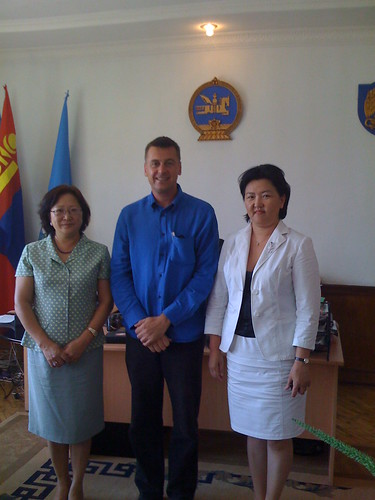
Meeting the Director of Chingeltei District Health Unit and the Chairperson of the Chingeltei Council
I also met with the Deputy Governor of the district and with the Director of the City Health Unit. Each provided me with an overview of how their organisation fits into the overall health system. I will be working with these bodies over the next few weeks and they all expressed their willingness to help out on the project.
We went to see some of the CHDU premises after lunch. I went to two GP practices - one old and one new. The facilities were quite basic compared to western standards and the quality of construction left room for improvement. Both of the GP practices served the Ger districts on the outskirts of the capital.

Ger District on the outskirts of Ulanbataar
I also visited the two Ambulatory premises. Both were in need of serious refurbishment. Coupled with that, the equipment looked like it has been there for a very long time.
After work I headed over to a dinner with other VSO volunteers. At this time of the year many volunteers are finishing their placement. As a result there are a lot of "farewell parties". Also, their replacements are now arriving. So it's a constant flow of people out of and in to the volunteer network.
The volunteers come from all walks of life and from right around the world. I've met people from Australia, New Zealand, America, Europe, Africa and Asia. The ages range from early 20's to early '70s (the cut-off age is 75, but I believe that this is being re-considered). So, one is never too young or old to become involved!
We met with the Director of the CHDU and her staff and had a one-hour question and answer session about the District and about what they hoped that I could help with over the coming few weeks. They also gave me an overview of the area they work in.
UB is split up into 9 Duuregs. Each has their own local government structure. I have been assigned to the Chingeltei district. It's population is about 160,000 (about the size of Meath) and it stretches from the city centre right out to the hills surrounding the capital. There are 18 sub-districts, or Khoroos, different in character and ranging from city businesses to Ger encampments.
CHDU has 18 family General Practices (like local GPS), one for each Khoroo. Each deals with between 3,000 and 10,000 people. Usually these have between 4-6 doctors and 4-6 nurses. There are NO administrative staff. All reception work and filing is done by the doctors and nurses themselves.
There are also two ambulatory buildings (assessment, consultation, dental services, outpatients) two polyclinics and one General hospital.
The Director then took me to meet some key people in other institutions. The first was the Chairperson of Chingeltei Representatives - she was elected by the 35 local area representatives. She outlined her hopes for an improved heath service, and believes that new equipment for the area is essential.

Meeting the Director of Chingeltei District Health Unit and the Chairperson of the Chingeltei Council
I also met with the Deputy Governor of the district and with the Director of the City Health Unit. Each provided me with an overview of how their organisation fits into the overall health system. I will be working with these bodies over the next few weeks and they all expressed their willingness to help out on the project.
We went to see some of the CHDU premises after lunch. I went to two GP practices - one old and one new. The facilities were quite basic compared to western standards and the quality of construction left room for improvement. Both of the GP practices served the Ger districts on the outskirts of the capital.

Ger District on the outskirts of Ulanbataar
I also visited the two Ambulatory premises. Both were in need of serious refurbishment. Coupled with that, the equipment looked like it has been there for a very long time.
After work I headed over to a dinner with other VSO volunteers. At this time of the year many volunteers are finishing their placement. As a result there are a lot of "farewell parties". Also, their replacements are now arriving. So it's a constant flow of people out of and in to the volunteer network.
The volunteers come from all walks of life and from right around the world. I've met people from Australia, New Zealand, America, Europe, Africa and Asia. The ages range from early 20's to early '70s (the cut-off age is 75, but I believe that this is being re-considered). So, one is never too young or old to become involved!
Monday, August 11, 2008
Briefing from the VSO
I was dog-tired by the time I got to bed at 10pm on Sunday. I decided to stay up for the day, so that I would sleep all night. It worked, and I woke up as normal at 8am on Monday, ready and fit for the day ahead.
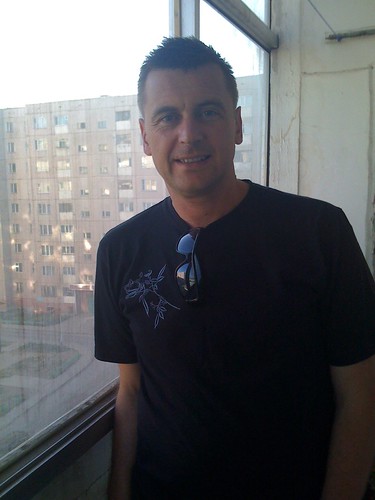
At home in the Soviet style apartment block
Our first day was spent at the VSO HQ in downtown Ulanbataar. The Country Director, Alison, gave us an overview of the political situation in Mongolia. There were fairly serious riots in early July, brought on by political discontent. However the trouble seems to have subsided for the moment, so we are expecting a peaceful few weeks.
Most volunteers spend their first four weeks getting an overview. It includes training on language, learning about the country and the specific areas of work. Ours was concentrated into just a day. We received a health and safety briefing, a security briefing, a briefing on the culture and beliefs (did you know for instance that if a Mongolian baby urinates on you then your or your wife is likely to become pregnant?).
We also received a briefing on our specific placements. I will be working in north inner Ulanabatter on issues in relation to the financial management of a health district.
Our final briefing was on matters related to life in the capital, and it covered stuff like transport, shopping and where to eat.
A very intensive day, but I came away with a clearer picture of what the next three weeks were going to be about.

At home in the Soviet style apartment block
Our first day was spent at the VSO HQ in downtown Ulanbataar. The Country Director, Alison, gave us an overview of the political situation in Mongolia. There were fairly serious riots in early July, brought on by political discontent. However the trouble seems to have subsided for the moment, so we are expecting a peaceful few weeks.
Most volunteers spend their first four weeks getting an overview. It includes training on language, learning about the country and the specific areas of work. Ours was concentrated into just a day. We received a health and safety briefing, a security briefing, a briefing on the culture and beliefs (did you know for instance that if a Mongolian baby urinates on you then your or your wife is likely to become pregnant?).
We also received a briefing on our specific placements. I will be working in north inner Ulanabatter on issues in relation to the financial management of a health district.
Our final briefing was on matters related to life in the capital, and it covered stuff like transport, shopping and where to eat.
A very intensive day, but I came away with a clearer picture of what the next three weeks were going to be about.
Sunday, August 10, 2008
With the VSO in Mongolia
This year is the 50th anniversary of the setting up of the VSO. As part of their celebrations they invited members of the Oireachtas to become volunteers for a few weeks during the summer.
I have always been interested in working as a volunteer, but generally the minimum commitment was for at least a year and I was unable to find the time for that. This program is just for three weeks so I jumped at the chance of volunteering.
In all there are six members of the Oireachtas volunteering. Myself and Leo Varadker have been sent to Mongolia to work on health service reforms. The others were sent to Africa.
We boarded an Aeroflot flights to Moscow on early Saturday morning and, after a three hour stop in Moscow, changed onto another plane for Ulanbaatar, the capital of Mongolia.
The flight was fine. The last time I flew with Aeroflot was five years ago. It was the only time in my life that I was on a plane that had to abort its landing. It seems that the air traffic control guys hadn't told our pilot that there was already a plane on the runway. Anyway we landed safely. So, I was slightly anxious before the plane took off. However, this time around the planes looked better and the service was faultless. It was actually quite a comfortable ride.
When we touched down in the capital we were met by the local office head, who immediately took us for a health and safety briefing. The main concern seems to be the prevalence of pick-pockets. I was fading rapidly and when I got to my apartment I had a quick coffee with my new flatmate (also a volunteer) and then went to bed for a few hours.
I forced myself up at noon and although still tired, I went out for a walk in the town. The weather is about 30 degrees C and the skies are cloudless. Here's a picture of me in Suhkbataar Square with a statue of Genghis Khan in the backgrounds.
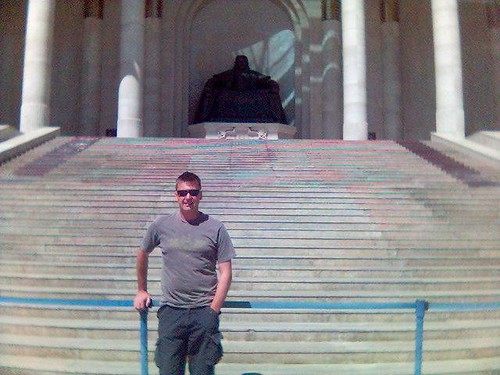
In Suhkbataar Square
I went out to a vegetarian restaurant for lunch, where I had soya chicken curry. Yes, even in Mongolia there are vegetarian restaurants!
Work starts early tomorrow morning. I'm hoping that I will be over my tiredness by then.
I have always been interested in working as a volunteer, but generally the minimum commitment was for at least a year and I was unable to find the time for that. This program is just for three weeks so I jumped at the chance of volunteering.
In all there are six members of the Oireachtas volunteering. Myself and Leo Varadker have been sent to Mongolia to work on health service reforms. The others were sent to Africa.
We boarded an Aeroflot flights to Moscow on early Saturday morning and, after a three hour stop in Moscow, changed onto another plane for Ulanbaatar, the capital of Mongolia.
The flight was fine. The last time I flew with Aeroflot was five years ago. It was the only time in my life that I was on a plane that had to abort its landing. It seems that the air traffic control guys hadn't told our pilot that there was already a plane on the runway. Anyway we landed safely. So, I was slightly anxious before the plane took off. However, this time around the planes looked better and the service was faultless. It was actually quite a comfortable ride.
When we touched down in the capital we were met by the local office head, who immediately took us for a health and safety briefing. The main concern seems to be the prevalence of pick-pockets. I was fading rapidly and when I got to my apartment I had a quick coffee with my new flatmate (also a volunteer) and then went to bed for a few hours.
I forced myself up at noon and although still tired, I went out for a walk in the town. The weather is about 30 degrees C and the skies are cloudless. Here's a picture of me in Suhkbataar Square with a statue of Genghis Khan in the backgrounds.

In Suhkbataar Square
I went out to a vegetarian restaurant for lunch, where I had soya chicken curry. Yes, even in Mongolia there are vegetarian restaurants!
Work starts early tomorrow morning. I'm hoping that I will be over my tiredness by then.

